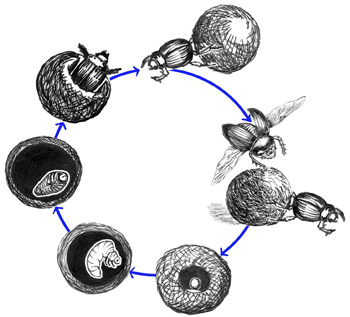
Dung beetles life cycle: a pair of dung beetles take care of a ball of dung where the female will deposit an egg. The larva that hatches from the egg will eat the dung and develop into an adult through metamorphosis.
X
Illustration by Aura Paucar-Cabrera, copyright 2009. |
|
Like all beetles, scarab beetles have complete metamorphosis. The life cycle includes the egg (laid by the female scarab beetle), larvae which feed and grow and are C-shaped, pupae which are similar to the cocoon stage in moths, and adults which mate and begin the cycle again.
Scarab larvae feed on roots, decaying plant material, dung (or poop), and carrion (dead animals). Scarab adults feed on a wide variety of foods including fruits, mushrooms, plants, carrion (dead animals), dung (poop), flowers, leaves, pollen, nectar, and plant sap. Many adults are attracted to lights at night. You can observe the scarab beetles in your backyard by turning on the porch light and watching them fly to the light! |
